
HOT ROD's latest project car is a Factory Five Cobra that has been a long time coming. We've had the basic kit for quite some time now, but a project of this magnitude brings out our innermost procrastination tendencies, and that means it has gone much slower than we intended. With the ever-oppressing magazine deadlines getting in the way, we tapped on the shoulder of John Balow at Musclecar Restorations to help us build the car. You'll see more about that in ensuing months, but while Balow's guys were doing their thing to the Factory Five kit, we concentrated on something we know a little more about, and that's the engine.
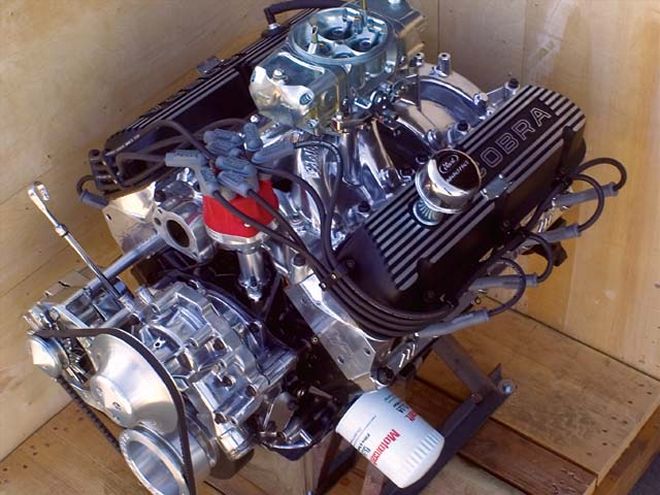 Coast High Performance claims this engine makes 554 hp and nearly the same torque. We'll find out when we run it in the car.
Coast High Performance claims this engine makes 554 hp and nearly the same torque. We'll find out when we run it in the car.
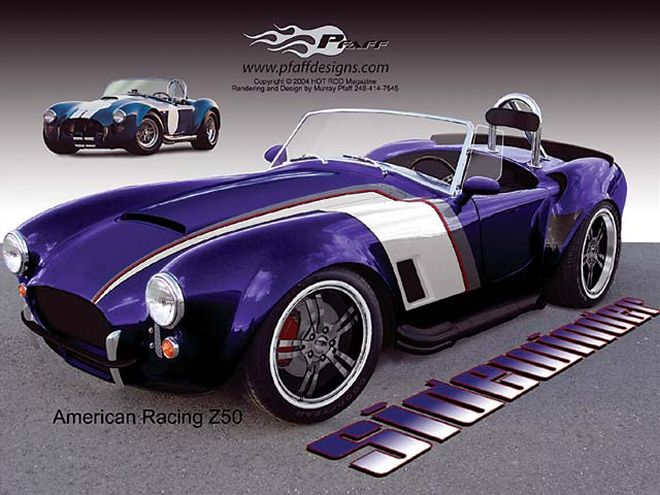 Murray Pfaff designed the look of our Factory Five project, including the paint and a few custom touches. Musclecar Restorations is making it look like this.
Murray Pfaff designed the look of our Factory Five project, including the paint and a few custom touches. Musclecar Restorations is making it look like this.
The nice thing about a Factory Five Cobra is that you can use nearly any engine you want. We've seen everything from legit 427 FEs to twin-turbo small-block Chevys and even a few DOHC 4.6 mod motors crammed into the small engine bay. In this writer's humble opinion, a Cobra has to at least have a Ford engine, and preferably a 427. But even with the resurgence in FE popularity, a real 427 side oiler is expensive and really, really heavy. If you can get the same (or more) power in a much lighter small-block Ford and yet still be able to stick some 427 badges on the car, so much the better, right? So that's what we did, and we didn't have to look much further than Coast High Performance (CHP) in Torrance, California.
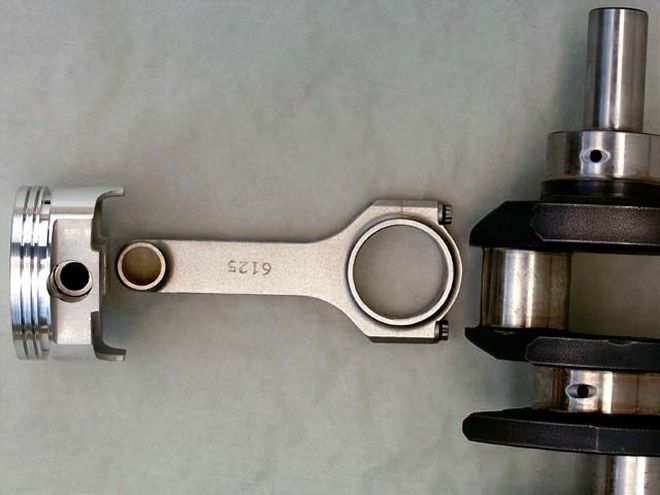 Running a hydraulic-roller cam in a block not designed for it requires Comp's Roller Lifter Retro-Fit Kit (part no. 31-1000), which requires drilling and tapping two holes in the bottom of the lifter valley to retain the sheetmetal spider that holds the lifter dog bones in place. The cast stroker crank arms are 4.170 inches and the H-beam rods are a long 6.200 inches. That requires a piston with a 1.235-inch compression height. These are forged Probe SRS slugs, and they wear 1⁄16-inch top and second and 3mm oil rings. Compression is 9.9:1.
Running a hydraulic-roller cam in a block not designed for it requires Comp's Roller Lifter Retro-Fit Kit (part no. 31-1000), which requires drilling and tapping two holes in the bottom of the lifter valley to retain the sheetmetal spider that holds the lifter dog bones in place. The cast stroker crank arms are 4.170 inches and the H-beam rods are a long 6.200 inches. That requires a piston with a 1.235-inch compression height. These are forged Probe SRS slugs, and they wear 1⁄16-inch top and second and 3mm oil rings. Compression is 9.9:1.
CHP's troublemaker is called the Cobra Classic, and it's all of 427 ci via a production late-model two-bolt-main 351W block bored 0.030-over and stroked with a 4.170-inch cast crank. Stroker small-block Fords are like 383 Chevys these days; if you're rebuilding an engine and need to buy a crankshaft anyway, it's basically the same money to put a stroker crank in it, so why not take the cubes? The most popular stroker kits are based off the 8.2-deck 302 block, and 347 seems to be the magic cubic-inch number, but using the taller 9.5-deck 351W block, there are several popular stroker combos, including the magical 427. The bigger you go, of course, the more complicated it gets, but even at the 427 level there's not a lot of fuss involved in assembling the package. A little grinding on the bottoms of a few cylinders and the correct selection of parts, including a camshaft with a reduced base circle, and it falls together pretty easily.
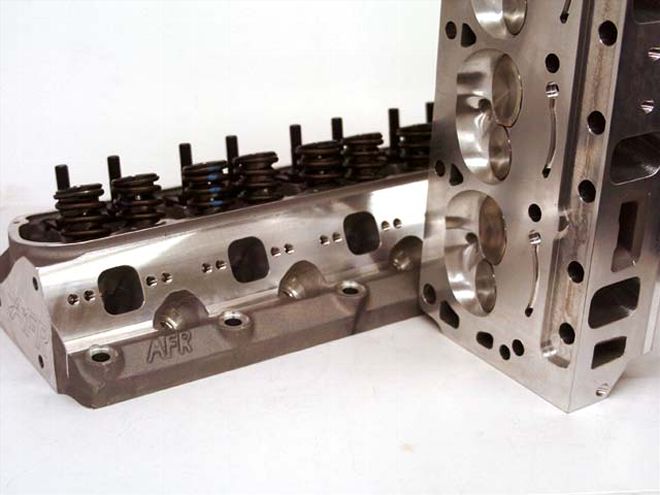 The Sidewinder Cobra gets the optional Airflow Research cylinder heads with 205cc intake runners and 58cc chambers. These heads are CNC-ported from AFR so Coast doesn't touch them. If more power is needed, you can also step up to the AFR 225s.
The Sidewinder Cobra gets the optional Airflow Research cylinder heads with 205cc intake runners and 58cc chambers. These heads are CNC-ported from AFR so Coast doesn't touch them. If more power is needed, you can also step up to the AFR 225s.
The power parts that make up the Cobra Classic small-block center around a CHP stroker kit that uses the aforementioned crank as well as 6.125-inch H-beam rods and Probe SRS forged and dished pistons. A Probe cast-iron main girdle strengthens the bottom of the production block. The heads used on the standard Cobra Classic are out-of-the-box Edelbrock Victor Jr.'s, but we went for the optional CNC-ported Airflow Research 205s with 58cc chambers, which CHP claims are worth about 30 hp. Induction is from an Edelbrock Victor Jr. intake and a Race Demon 950-cfm carburetor. The cam is a relatively mild hydraulic roller from Pro Mustang with 0.050 duration at 248/256, 0.595/0.605 lift, and a 110-degree lobe separation angle. With 427 cubes, it's a perfectly driveable cam but big enough to crank out a claimed 554 hp at 5,600 rpm and 552 lb-ft of torque at 4,800.
We state "claimed" horsepower since we didn't have a chance to verify it. Due to time constraints induced by the rapidly approaching Power TourTM (the car had to be done in time or the entire HOT ROD staff would be fired), we didn't have a chance to prove those numbers on our own dyno--we got them from the dyno sheet provided by CHP, with testing taking place at Dyno-Motive in Placentia, California. The engine used in that test had the same AFR heads but a Holley 830 carb. We'll be putting the car on a chassis dyno once it is finished and tuned and report back with more accurate, eye-witnessed numbers.
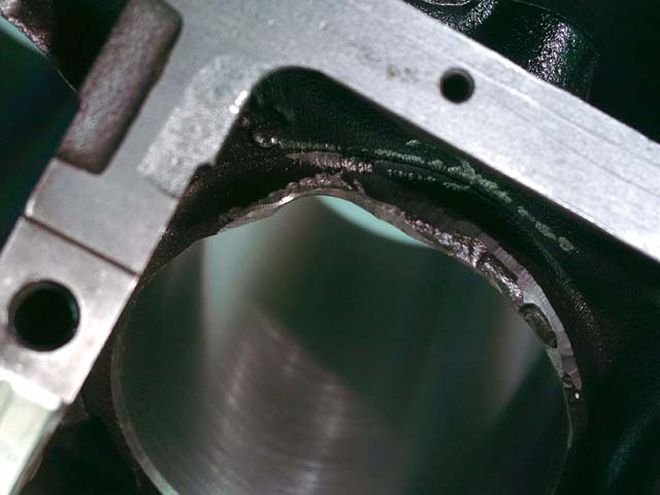 The long stroke requires some work with a grinder at the bottoms of the bores, but it's nothing extreme. The cam must also have a reduced base circle.
The long stroke requires some work with a grinder at the bottoms of the bores, but it's nothing extreme. The cam must also have a reduced base circle.
The parts are not the whole story, however, since the main selling feature is that this is a crate engine that comes complete from carb to pan, and with a full front accessory dress including pulleys, a water pump, and a one-wire alternator. Unpolished, the whole kit and kaboodle will set you back $9,500, plus $600 for the hydraulic-roller cam (a hydraulic flat-tappet is standard), and $400 for the AFR heads instead of the Edelbrock Victor Jrs. Add another $800 for polished heads, intake, and water pump, and the engine you're looking at here, which you'll see under the blue 'glass hood of the FFR Cobra, goes in the crate for $11,300 and is literally ready to drop in a car, plug in the wiring, hook up the fuel line, and drive down the road.
Of course, now there's the matter of building the rest of the car, not an undaunting task by itself. We'll head up north to Minnesota to cover building the Factory Five kit and fitting the engine and Tremec five-speed trans next month, and then we'll be revving the snot out of this big small-block and putting the car through its paces on the chassis dyno and at the dragstrip.
Dyno Numbers:
RPMHPLB-ft4,0003714874,2004055074,4004445304,6004785464,8005045525,0005235495,200537543
Details:
* Holley 830-cfm carb with 85/95 jets and 0.032 inner/0.067 outer air bleeds
* 1-inch four-hole spacer
* 91-octane fuel
* Timing set at 36 degrees total advance
* Uncorrected altitude of 446 feet